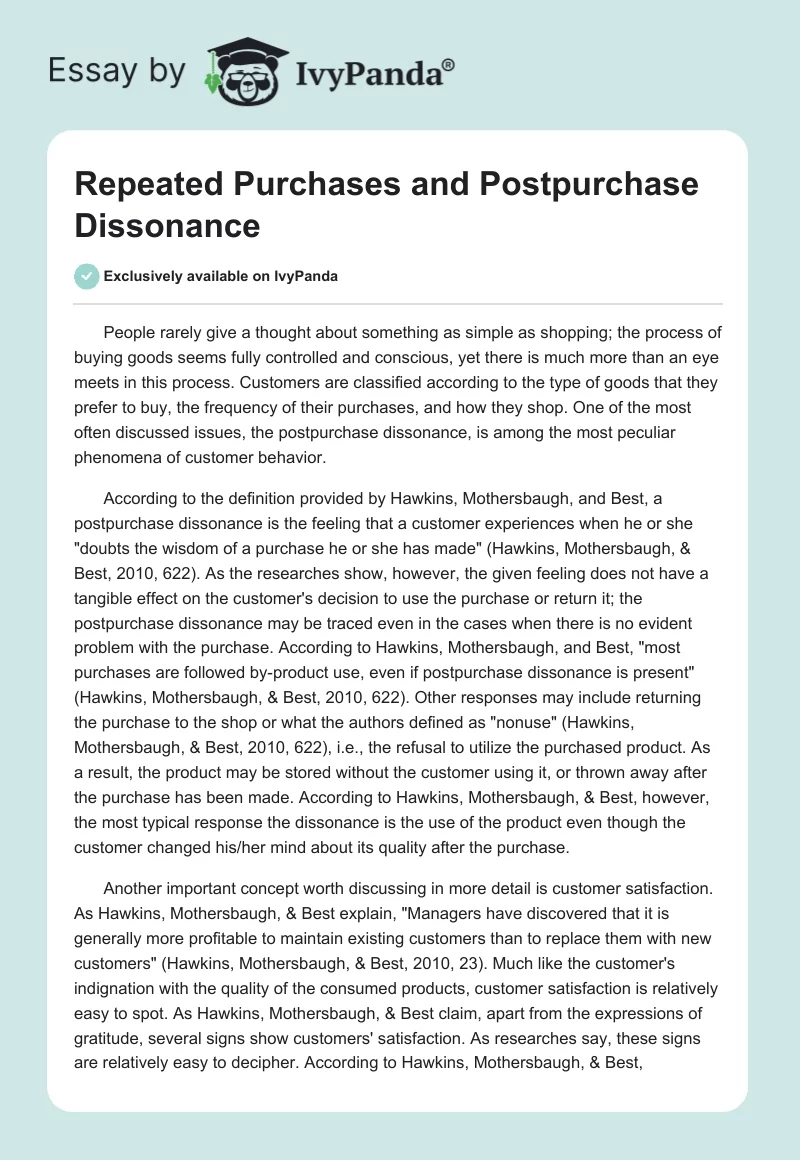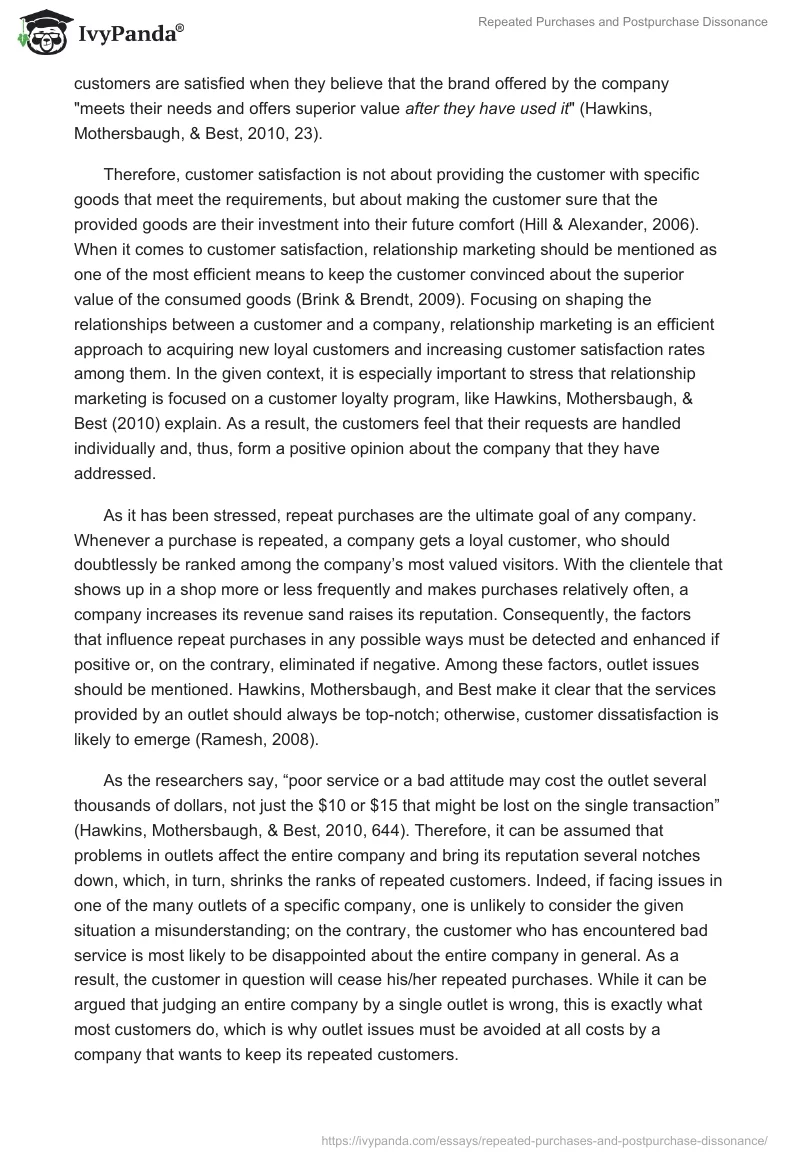People rarely give a thought about something as simple as shopping; the process of buying goods seems fully controlled and conscious, yet there is much more than an eye meets in this process. Customers are classified according to the type of goods that they prefer to buy, the frequency of their purchases, and how they shop. One of the most often discussed issues, the postpurchase dissonance, is among the most peculiar phenomena of customer behavior.
According to the definition provided by Hawkins, Mothersbaugh, and Best, a postpurchase dissonance is the feeling that a customer experiences when he or she “doubts the wisdom of a purchase he or she has made” (Hawkins, Mothersbaugh, & Best, 2010, 622). As the researches show, however, the given feeling does not have a tangible effect on the customer’s decision to use the purchase or return it; the postpurchase dissonance may be traced even in the cases when there is no evident problem with the purchase. According to Hawkins, Mothersbaugh, and Best, “most purchases are followed by-product use, even if postpurchase dissonance is present” (Hawkins, Mothersbaugh, & Best, 2010, 622). Other responses may include returning the purchase to the shop or what the authors defined as “nonuse” (Hawkins, Mothersbaugh, & Best, 2010, 622), i.e., the refusal to utilize the purchased product. As a result, the product may be stored without the customer using it, or thrown away after the purchase has been made. According to Hawkins, Mothersbaugh, & Best, however, the most typical response the dissonance is the use of the product even though the customer changed his/her mind about its quality after the purchase.
Another important concept worth discussing in more detail is customer satisfaction. As Hawkins, Mothersbaugh, & Best explain, “Managers have discovered that it is generally more profitable to maintain existing customers than to replace them with new customers” (Hawkins, Mothersbaugh, & Best, 2010, 23). Much like the customer’s indignation with the quality of the consumed products, customer satisfaction is relatively easy to spot. As Hawkins, Mothersbaugh, & Best claim, apart from the expressions of gratitude, several signs show customers’ satisfaction. As researches say, these signs are relatively easy to decipher. According to Hawkins, Mothersbaugh, & Best, customers are satisfied when they believe that the brand offered by the company “meets their needs and offers superior value after they have used it” (Hawkins, Mothersbaugh, & Best, 2010, 23).
Therefore, customer satisfaction is not about providing the customer with specific goods that meet the requirements, but about making the customer sure that the provided goods are their investment into their future comfort (Hill & Alexander, 2006). When it comes to customer satisfaction, relationship marketing should be mentioned as one of the most efficient means to keep the customer convinced about the superior value of the consumed goods (Brink & Brendt, 2009). Focusing on shaping the relationships between a customer and a company, relationship marketing is an efficient approach to acquiring new loyal customers and increasing customer satisfaction rates among them. In the given context, it is especially important to stress that relationship marketing is focused on a customer loyalty program, like Hawkins, Mothersbaugh, & Best (2010) explain. As a result, the customers feel that their requests are handled individually and, thus, form a positive opinion about the company that they have addressed.
As it has been stressed, repeat purchases are the ultimate goal of any company. Whenever a purchase is repeated, a company gets a loyal customer, who should doubtlessly be ranked among the company’s most valued visitors. With the clientele that shows up in a shop more or less frequently and makes purchases relatively often, a company increases its revenue sand raises its reputation. Consequently, the factors that influence repeat purchases in any possible ways must be detected and enhanced if positive or, on the contrary, eliminated if negative. Among these factors, outlet issues should be mentioned. Hawkins, Mothersbaugh, and Best make it clear that the services provided by an outlet should always be top-notch; otherwise, customer dissatisfaction is likely to emerge (Ramesh, 2008).
As the researchers say, “poor service or a bad attitude may cost the outlet several thousands of dollars, not just the $10 or $15 that might be lost on the single transaction” (Hawkins, Mothersbaugh, & Best, 2010, 644). Therefore, it can be assumed that problems in outlets affect the entire company and bring its reputation several notches down, which, in turn, shrinks the ranks of repeated customers. Indeed, if facing issues in one of the many outlets of a specific company, one is unlikely to consider the given situation a misunderstanding; on the contrary, the customer who has encountered bad service is most likely to be disappointed about the entire company in general. As a result, the customer in question will cease his/her repeated purchases. While it can be argued that judging an entire company by a single outlet is wrong, this is exactly what most customers do, which is why outlet issues must be avoided at all costs by a company that wants to keep its repeated customers.
Reference List
Brink, A. & Brendt, A. (2009). Relationship marketing and customer relationship management. South Africa: Juta and Co., Ltd.
Hawkins, D. I., Mothersbaugh, D. L., & Best, R. J. (2010). Consumer behavior: Building marketing strategy (11th ed.). Boston: McGraw Hill.
Hill, N. & Alexander, J. (2006). The handbook of customer satisfaction and loyalty measurement. Burlington, VT: Ashgate Publishing Company.
Ramesh, K. (2008). Conceptual issues in consumer behavior: the Indian context. New Delhi: First Impression.


